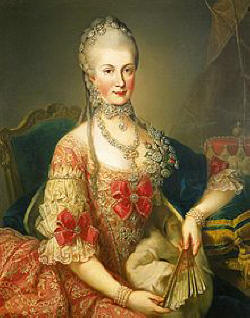

Queer Places:
Bratislava Castle, 811 06 Bratislava, Slovacchia
 Maria Christina, Duchess of Teschen (Maria Christina Johanna Josepha
Antonia; 13 May 1742 – 24 June 1798), was the fifth child of Maria Theresa of
Austria and Francis I, Holy Roman Emperor. Married in 1766 with Prince Albert
of Saxony, they received the Duchy of Teschen and also was appointed Governor
of the Austrian Netherlands jointly with her husband during 1781–1789 and
1791–1792. After two expulsions from the Netherlands (in 1789 and 1792), she
lived with her husband in Vienna until her death.
Maria Christina, Duchess of Teschen (Maria Christina Johanna Josepha
Antonia; 13 May 1742 – 24 June 1798), was the fifth child of Maria Theresa of
Austria and Francis I, Holy Roman Emperor. Married in 1766 with Prince Albert
of Saxony, they received the Duchy of Teschen and also was appointed Governor
of the Austrian Netherlands jointly with her husband during 1781–1789 and
1791–1792. After two expulsions from the Netherlands (in 1789 and 1792), she
lived with her husband in Vienna until her death.
The 17-years-old Maria Christina had a romance with Duke Louis Eugene of Württemberg, but a marriage between them displeased the Empress, who believed that the third son of the Duke of Württemberg wasn't of enough rank for an Archduchess. In early January 1760 arrived to the Imperial court Princes Albert and Clemens of Saxony and both were warmly received by the Emperor and Empress. Prince Albert met the lovely Archduchess on the occasion of a concert, in which she participated, and soon he took a great affection for her, as he recalled in his memoirs. At the end of January 1760, Albert and Clemens returned from Vienna.
In the following years, Maria Christina developed an intense love affair[1] with Princess Isabella of Parma, who married on 6 October 1760 with the future Emperor Joseph II. Among other things, the two young women often played together. The beautiful, educated, and very sensitive Isabella, who detested the court ceremonial and her position as wife of the Habsburg heir, wanted a more sensual destiny; however, despite this inner attitude, she appeared to be cheerful and satisfied with her fate. While her husband loved her very deeply, she was cold towards him. On the contrary, for Maria Christina she had a heartfelt affection, expressed in about 200 letters between them, usually written in French. The two women seemed to have a romantic lesbian affair.[2][3] They spent so much time together that they earned the comparison with Orpheus and Eurydice. Isabel and Mimi were united not only by a shared interest in music and art but also by a deep mutual love.[4] Every day they wrote long letters to each other in which they revealed their feelings of love.
Maria Christina made a formal description of Isabella, in which she portrayed here as amiable, kind, and generous, but she also did not spare her weaknesses. The early demise of her sister-in-law (who was more and more inclined to melancholy and a growing obsession with death) on 27 November 1763 following childbirth complications, left Maria Christina heartbroken.[5]
My published books: